Nine months have gone by since I first concluded
that my garden and
mini-farm was under a fungal infestation. The dry season has come and
gone and another rainy season has begun. I described in
my
previous
article what I call a black fungus, generally attached to the upper
sides of leaves and a white infestation, generally attached to the
under side of leaves. Local conventional wisdom has it that the two are
related, that the black fungus are the excretions of the white fly,
which itself is responsible for and/or breeds in the white infestation.
In the past year I've not been able to fully convince myself of this.
The two attachments, white and black, are to the naked eye and
semi-casual observer quite distinct and clearly demarcated in location.
Viewed with admittedly aging eyes, it's quite hard to believe even that
the loose, white powdery substance on the under sides of leaves, and/or
sometimes scattered on the ground beneath, is or
contains the infamous whitefly or its young. One is yet to see a winged
creature, however small, emerge. However, younger eyes assure me that
there is a living thing at least sometimes embedded within this powder.
The white fly itself does appear at certain times, insubstantial and
floating around the vegetation, in some numbers but not in what could
be called clouds. How and when these tiny
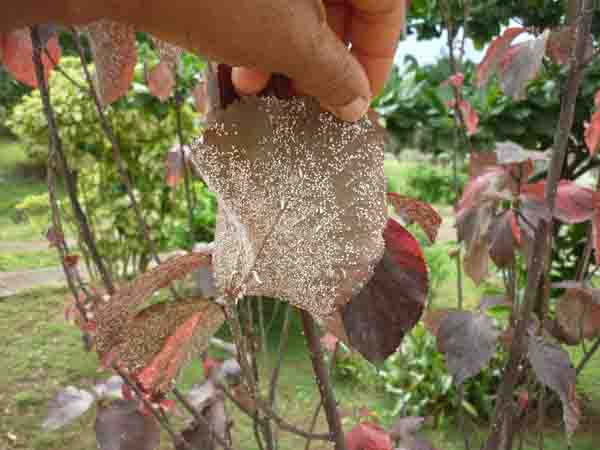
creatures generate the copious
amounts of the loose, white powder and
coat the upper sides of the leaves with
the more stubborn, black fungus is, for now, completely beyond me. In
this article I use the term "white powder" to refer to the loose
substance clinging to the leaves and "white fly" to refer to the tiny,
presumably winged creatures that one sees at times floating about.
Anecdotal information indicates that this problem is widespread in the
Western Area and has affected agriculture, in particular citrus
production, in the interior of Sierra Leone. There has been a marked
reduction of oranges on display in local markets. The fruit sellers
have no idea why their supply has dried up. Gardeners I talk to in the
city and up in the mountain villages report the presence of white fly
and black fungus. I observe the presence of white powder on ornamental
shrubs in the heart of Freetown
Additional internet research continues to dismay. Whitefly is a large
and growing threat all over Africa, costing billions of dollars in lost
agricultural production. The hundreds of identified varieties, each
with its own characteristics and with growing pesticide resistance,
thrive in African climactic conditions and attack a wide range of
African crops, in some cases causing 100% losses. Pity our poor farmer,
all is forgiven! The problem has attracted the attention of top
research scientists and international funding institutions. Only a few
days ago scientists announced the unraveling of the genome of the
cassava B. tabaci whitefly, which
has devastated cassava production in some areas. Achieved through
considerable scientific effort and material expense, this is just one
step towards combatting just one of the numerous and expanding
population of African bugs.
The infestation on my farm loves
shrubs and
citrus
trees. Large trees appear to be
more resistant. Pear, walnut and mango trees have not been
seriously affected. Paw-paw too, though a much smaller tree, is not at
all affected. Ornamental shrubs are quickly attacked and have a low
(possibly 10 - 20%) survival rate. Citrus too is quickly attacked but
can be more hardy, Some of my young citrus were observed to have shaken
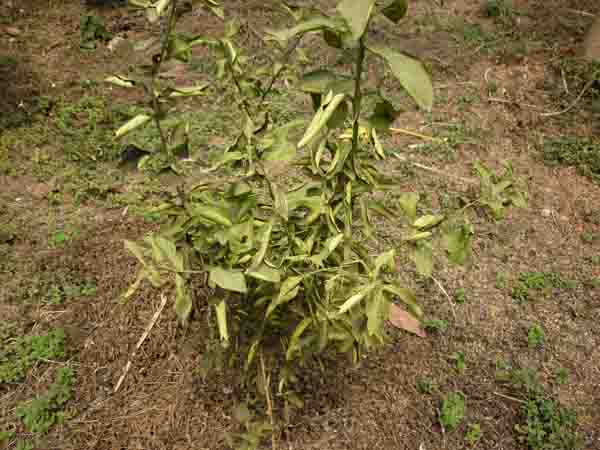
off the infestation during the dry
season,
possibly helped by the
curling and uncurling of the leaves; other young citrus struggled along
with the infestation clinging to them; others died. Hopes that the
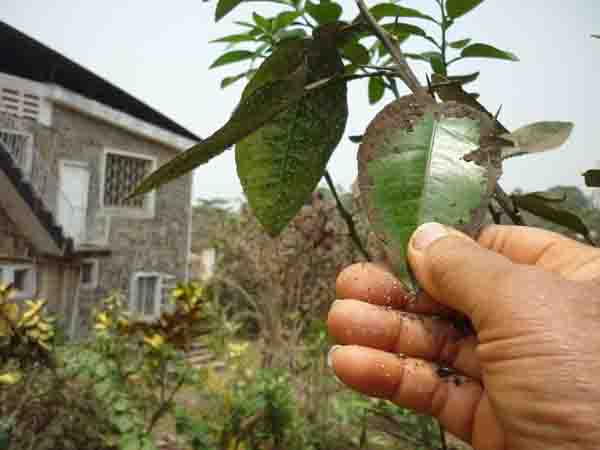
stubborn black fungus would dry,
crack and be blown off by harmattan
winds proved overoptimistic, although to some limited extent this may
have happened. Even though white fly itself seemed to have disappeared
at the height of the dries, one was able to identify new infestations
of white powder, sometimes on top of the old and cracking black fungus;
these fresh infestations during the dries were not seen with the black
fungus,
lending weight to the argument that these two might be unrelated.
Internet research indicates some species of whitefly excrete a honeydew
which promotes the growth of black fungus. I haven't seen this
honeydew, though. And why does the black fungus grow on the
tops of the leaves with the white
powder on the
bottom?
Spread of the white
powder appears to be from
the bottom of the tree or
shrub upwards. One sees infestations where the bottom of the tree is
affected but not the top, but the reverse situation is not usually
encountered. A preventive strategy perhaps could concentrate on the
base of trees and shrubs. The attack may be aided by dead undergrowth
around the
base of the plant. One frequently sees much evidence of the white
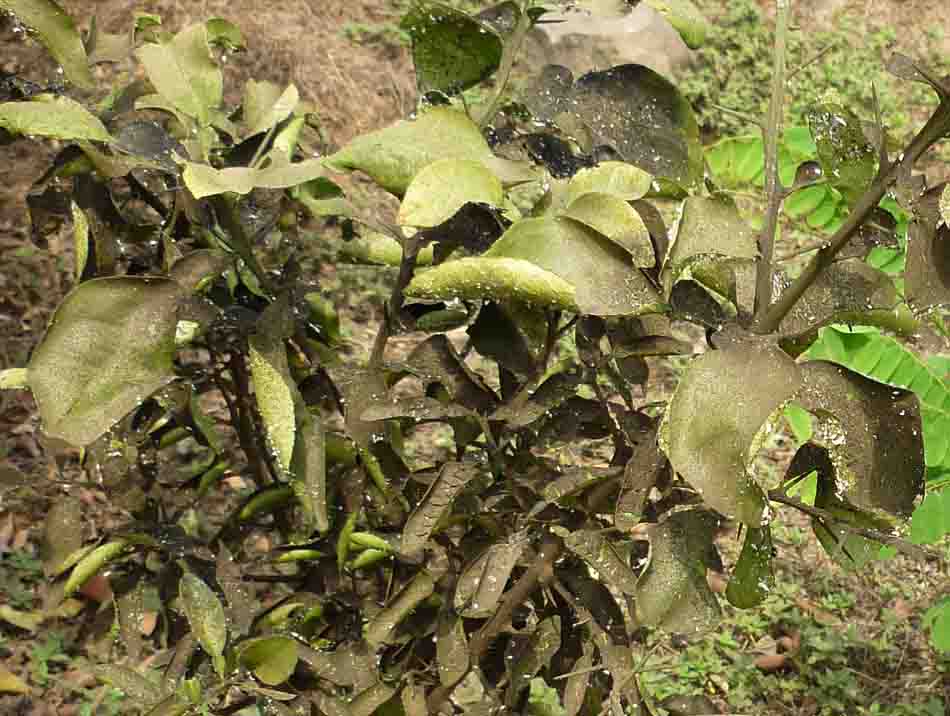
powder on this undergrowth,
although some of
this may have fallen
downwards from the plant rather than be in the process of moving up.
It's impossible to say because any movement of the white powder is
glacially slow.
Spraying of insecticide on infected
plants appears at first to have no
effect. Both the white powder and the black fungus remain exactly as
they were. Repeated spraying, however, looks like it may stop the
infestation although the exact mechanism of this is at this point
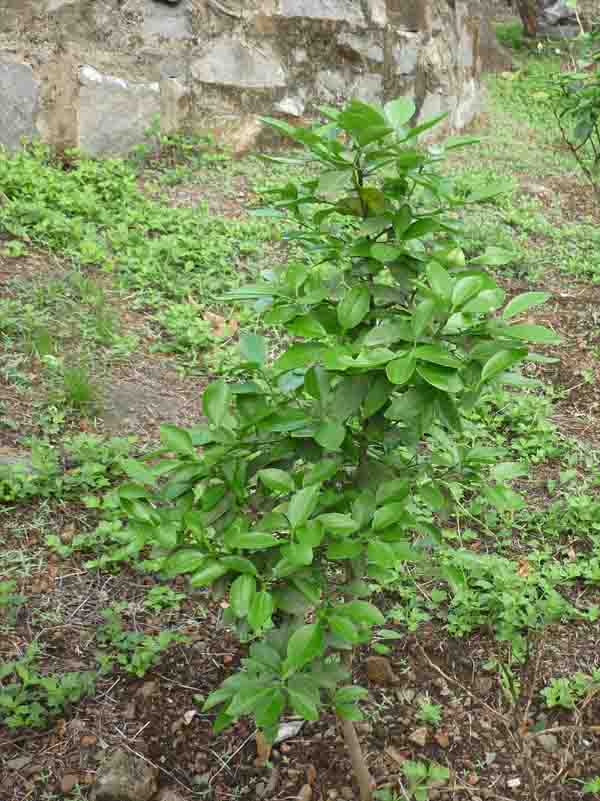
unclear. Agricultural whitefly
insecticide
was used with
a backpack sprayer, but
on small shrubs and seedlings ordinary household aerosol insecticides
also seemed effective. The start of rains has prompted the generation
of
new leaves which are, for now, free of infestation. On fully grown,
infected citrus trees effective spraying seems impossible with a
backpack sprayer. The only options for the small farmer appear to be to
allow the infection to run its course or to cut the tree to a
manageable height and then spray.
My planting season
has begun, with more
paw-paw, citrus,
ornamental shrubs and a few other specialty items. A good percentage of
my shrubs and citrus trees are dead. I'll be using my new backpack
sprayer much more regularly this year. My first citrus are four to five
years old (it's difficult to keep track of exactly when all these
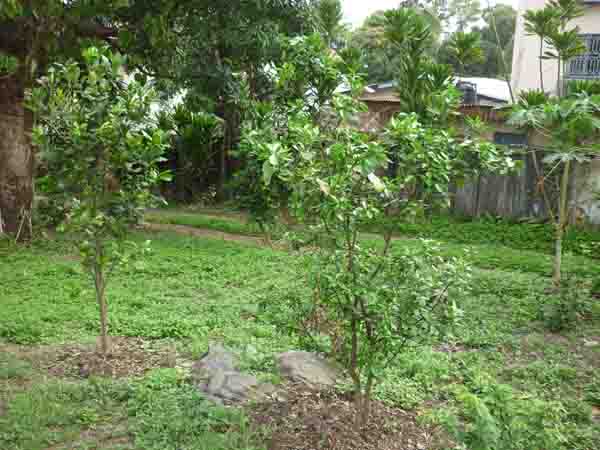
things were planted), about the age
when it's
said first fruit begin.
They are about 7 feet tall, and just about recovered from white fly
and black fungus, but I doubt I'll get any fruit out of them this year.
The paw-paw too have been a disappointment. Most have borne few fruit
and after initial fast growth (perhaps too fast) have shrivelled up and
eventually toppled over. I am experimenting with different varieties
and different environments. The saving grace about pawpaw is that they
grow so fast that in a year the results of your experiments are in.
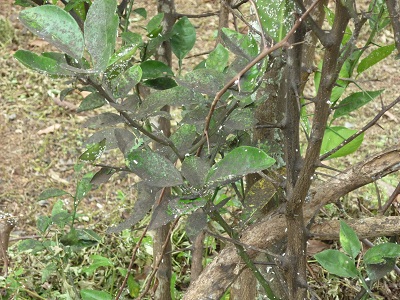

 creatures generate the copious
amounts of the loose, white powder and
coat the upper sides of the leaves with
the more stubborn, black fungus is, for now, completely beyond me. In
this article I use the term "white powder" to refer to the loose
substance clinging to the leaves and "white fly" to refer to the tiny,
presumably winged creatures that one sees at times floating about.
Anecdotal information indicates that this problem is widespread in the
Western Area and has affected agriculture, in particular citrus
production, in the interior of Sierra Leone. There has been a marked
reduction of oranges on display in local markets. The fruit sellers
have no idea why their supply has dried up. Gardeners I talk to in the
city and up in the mountain villages report the presence of white fly
and black fungus. I observe the presence of white powder on ornamental
shrubs in the heart of Freetown
creatures generate the copious
amounts of the loose, white powder and
coat the upper sides of the leaves with
the more stubborn, black fungus is, for now, completely beyond me. In
this article I use the term "white powder" to refer to the loose
substance clinging to the leaves and "white fly" to refer to the tiny,
presumably winged creatures that one sees at times floating about.
Anecdotal information indicates that this problem is widespread in the
Western Area and has affected agriculture, in particular citrus
production, in the interior of Sierra Leone. There has been a marked
reduction of oranges on display in local markets. The fruit sellers
have no idea why their supply has dried up. Gardeners I talk to in the
city and up in the mountain villages report the presence of white fly
and black fungus. I observe the presence of white powder on ornamental
shrubs in the heart of Freetown off the infestation during the dry
season,
possibly helped by the
curling and uncurling of the leaves; other young citrus struggled along
with the infestation clinging to them; others died. Hopes that the
off the infestation during the dry
season,
possibly helped by the
curling and uncurling of the leaves; other young citrus struggled along
with the infestation clinging to them; others died. Hopes that the
 stubborn black fungus would dry,
crack and be blown off by harmattan
winds proved overoptimistic, although to some limited extent this may
have happened. Even though white fly itself seemed to have disappeared
at the height of the dries, one was able to identify new infestations
of white powder, sometimes on top of the old and cracking black fungus;
these fresh infestations during the dries were not seen with the black
fungus,
lending weight to the argument that these two might be unrelated.
Internet research indicates some species of whitefly excrete a honeydew
which promotes the growth of black fungus. I haven't seen this
honeydew, though. And why does the black fungus grow on the tops of the leaves with the white
powder on the bottom?
stubborn black fungus would dry,
crack and be blown off by harmattan
winds proved overoptimistic, although to some limited extent this may
have happened. Even though white fly itself seemed to have disappeared
at the height of the dries, one was able to identify new infestations
of white powder, sometimes on top of the old and cracking black fungus;
these fresh infestations during the dries were not seen with the black
fungus,
lending weight to the argument that these two might be unrelated.
Internet research indicates some species of whitefly excrete a honeydew
which promotes the growth of black fungus. I haven't seen this
honeydew, though. And why does the black fungus grow on the tops of the leaves with the white
powder on the bottom? powder on this undergrowth,
although some of
this may have fallen
downwards from the plant rather than be in the process of moving up.
It's impossible to say because any movement of the white powder is
glacially slow.
powder on this undergrowth,
although some of
this may have fallen
downwards from the plant rather than be in the process of moving up.
It's impossible to say because any movement of the white powder is
glacially slow.  unclear. Agricultural whitefly
insecticide
was used with
a backpack sprayer, but
on small shrubs and seedlings ordinary household aerosol insecticides
also seemed effective. The start of rains has prompted the generation
of
new leaves which are, for now, free of infestation. On fully grown,
infected citrus trees effective spraying seems impossible with a
backpack sprayer. The only options for the small farmer appear to be to
allow the infection to run its course or to cut the tree to a
manageable height and then spray.
unclear. Agricultural whitefly
insecticide
was used with
a backpack sprayer, but
on small shrubs and seedlings ordinary household aerosol insecticides
also seemed effective. The start of rains has prompted the generation
of
new leaves which are, for now, free of infestation. On fully grown,
infected citrus trees effective spraying seems impossible with a
backpack sprayer. The only options for the small farmer appear to be to
allow the infection to run its course or to cut the tree to a
manageable height and then spray.  things were planted), about the age
when it's
said first fruit begin.
They are about 7 feet tall, and just about recovered from white fly
and black fungus, but I doubt I'll get any fruit out of them this year.
The paw-paw too have been a disappointment. Most have borne few fruit
and after initial fast growth (perhaps too fast) have shrivelled up and
eventually toppled over. I am experimenting with different varieties
and different environments. The saving grace about pawpaw is that they
grow so fast that in a year the results of your experiments are in.
things were planted), about the age
when it's
said first fruit begin.
They are about 7 feet tall, and just about recovered from white fly
and black fungus, but I doubt I'll get any fruit out of them this year.
The paw-paw too have been a disappointment. Most have borne few fruit
and after initial fast growth (perhaps too fast) have shrivelled up and
eventually toppled over. I am experimenting with different varieties
and different environments. The saving grace about pawpaw is that they
grow so fast that in a year the results of your experiments are in.